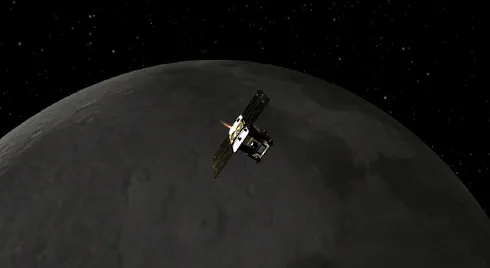
An artist's impression of GRAIL-B performing a lunar orbit insertion 'burn'
Credit: NASA/JPL-Caltech
The two spacecraft that together make up NASA's Gravity Recovery And Interior Laboratory (GRAIL) mission are now in lunar orbit, and ready to begin the process of measuring the Moon's gravity in unprecendented detail.
GRAIL-A reached lunar orbit at 20:00 UT on 31 December; its twin, GRAIL-B, went into orbit at 20:43 UT on 1 January. Over the next few weeks, a series of rocket 'burns' will gradually move the two craft nearer to the Moon, until they are in orbit at an altitude of 55km (34 miles), at which point the science stage of their mission will begin.
The two craft are equipped with radio transceivers, which can be used to calculate the distance between them very accurately. This enables scientists to chart the most minute variations in the Moon's gravitational field, which should tell us a lot more than we currently understand about our satellite's internal composition (see box below).
Each GRAIL craft is also equipped with a small camera, GRAIL MoonKam, which is solely for educational purposes. Students in US school grades 5 to 8 (ages 10-14) will be able to book imaging sessions using the cameras, in a project being spearheaded by former astronaut Sally Ride – the first American woman in space.
Announcing GRAIL-B's safe arrival at its destination, NASA Administrator Charles Bolden said: "NASA greets the new year with a new mission of exploration. The twin GRAIL spacecraft will vastly expand our knowledge of our Moon and the evolution of our own planet. We begin this year reminding people around the world that NASA does big, bold things in order to reach for new heights and reveal the unknown."
WHAT WILL GRAIL DO?
The latest mission to launch to the Moon has been designed to look at some longstanding lunar mysteries
The structure of impact basins
The mission will identify the structure of impact basins and the origin of mascons. Formed by huge impacts billions of years ago, the basins are now full of basaltic lava and overlie denser-than-average regions in the Moon’s upper mantle. GRAIL’s gravity measurements will map the detailed structure of the basins and shed light on the formation of the mascons.
Crustal conundrums
GRAIL will help scientists understand why the Moon’s crust is so variable. It should answer questions like how the Moon’s crustal rocks first became magnetised; when, how and how fast the crust became ‘brecciated’ – a process where smaller rock fragments are cemented together by a fine-grained matrix; and why thefar-side crust is, on average, 12km thicker than the near-side crust.
Construction of the core
It will also reveal whether the Moon has a solid inner core. Little is known about the centre of the Moon. Until recently, astronomers didn’t even know for sure whether the Moon had an iron core at all. A detailed study of lunar mare basalts indicated the presence of a partially molten core; GRAIL will be able to put limits on the size of a possible solid inner core.
Array